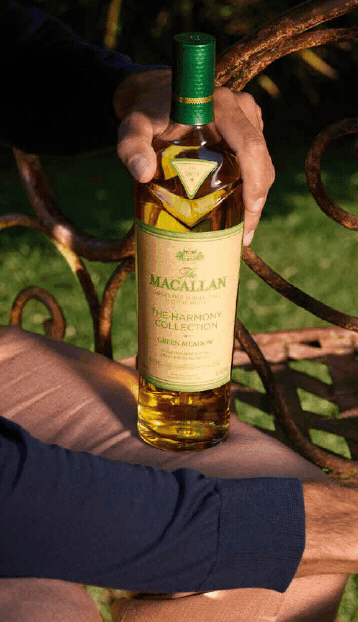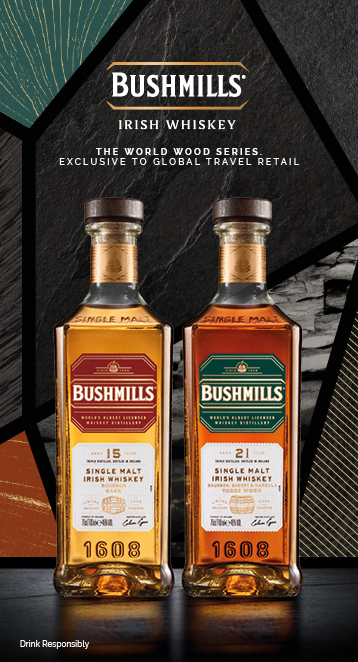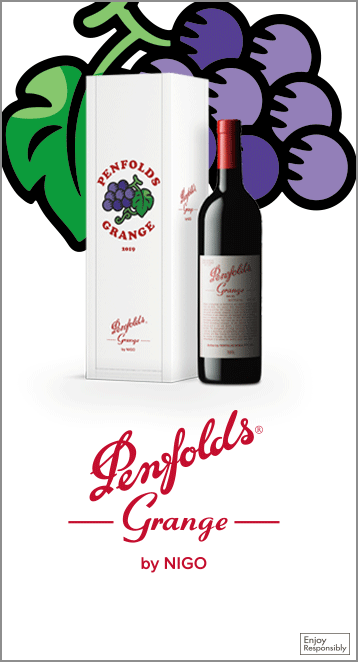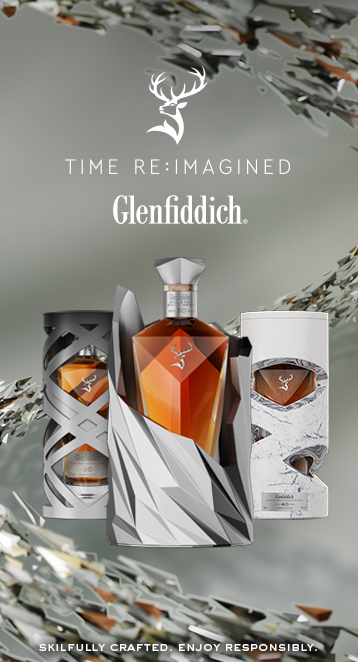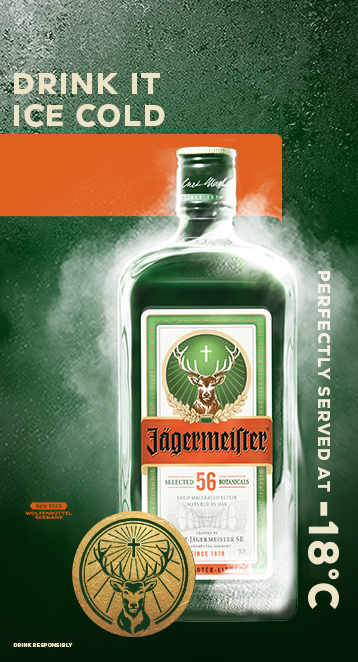Introduction: Diageo’s decision to relocate its travel retail division (now known as Diageo Global Travel) from Singapore to London in 2016 ushered in a series of related changes for the channel’s biggest drinks supplier. And now, says Managing Director, Dayalan Nayager, they’re bearing fruit. Late last year, he and Marketing and Innovation Director Anna MacDonald spoke with The Moodie Davitt Report Chairman Martin Moodie about an exciting pipeline, bursting with product, promotional and retail design innovation.
Nayager says his team comprises “vibrant, forward-thinking leaders made up of over 40 nationalities”, individuals who are in tune with the travel retail landscape and an evolving shopper profile. After Nayager, formerly Regional Director Europe, took over the reins as Managing Director from Doug Bagley, four regions were combined into three (Europe, Middle East & India; Asia Pacific; The Americas). In turn, the previous replication of finance and marketing teams in each region was replaced by a single marketing function led by London-based Marketing and Innovation Director Anna MacDonald, a youthful 17-year veteran of Diageo.

Addressing the perennial penetration dilemma
Diageo has long valued travel retail not simply as a critical sales channel but also as an outstanding showcase for new and established brands and expressions. Its core challenge is how to increase penetration at a time when liquor’s growth in the channel (+3% year-on-year till mid-2017, according to Generation) isn’t keeping up with traffic (+8.3% for the same period). The key airport channel (+6%) performed better but there’s still work to do, Nayager comments.
Diageo’s performance is broadly in line with the Generation numbers. But because travel retail in fast-growing Brazil and Turkey is handled by the company’s domestic arms, its true travel retail results are, in fact, stronger. Certainly, Diageo remains a clear market leader in travel retail spirits, with a 29% share by both volume and value [Source: IWSR],
Despite a flurry of new market entries and intense proliferation in some categories, Johnnie Walker (all expressions) has maintained its number one status over the past five years. In each of those, the world’s most popular Scotch whisky posted an annual volume increase. “It keeps growing year-on-year,” says Nayager. “Johnnie Walker is 2.564 million cases [IWSR 2016], versus the second brand at 894,000. So, we are +190% above the second brand. Even if you split Johnnie Walker into its sub-SKUs, Johnnie Walker Black on its own is bigger than the total second brand in the spirits category. So, it’s an important brand, not just for Diageo but also for the category.”

One of Diageo’s great success stories of recent years is the way it has constantly refreshed the Johnnie Walker franchise without damaging core references Red and Black Label. Johnnie Walker is now available in numerous expressions, both in terms of colour (Red, Black, Double Black, Gold, Platinum – recently renamed as Johnnie Walker Aged 18 Years) as well as Johnnie Walker Blue Label; The Explorers Club Collection; Johnnie Walker Island Green (a blended malt); the two-SKU (with more to come) Johnnie Walker Blenders’ Batch series; and the John Walker & Sons exclusive blends range.
That success has involved staying true to core expressions such as Johnnie Walker Black Label while continuously innovating in product range, merchandising, marketing and travel retail exclusives – for example Blenders’ Batch and Island Green.
In a powerhouse portfolio, success doesn’t only reside with Johnnie Walker. “We’ve got three of the top ten spirits brands by volume in travel retail,” says MacDonald, highlighting the performance of Baileys and Smirnoff in their respective crowded sectors. “And then across the key categories, we’ve either got the leading brand or numbers two and/or three.”
Some of those categories, particularly gin, have seen a flood of new entries, many of them in the fast-expanding craft spirits sector (see panel). But in each case the established Diageo entries are holding up well, MacDonald says. “Of course, there is a portion of travellers looking for something new and that’s very valid. But they’re also looking for brands that they know and trust. So, I think the category can support well-known and trusted brands as well as new entrants. It’s important to have both.”
“Digital will be critical in terms of communicating with customers. The investments are going to need to shift, for example from in-store communication to the full journey. The model needs to adapt to allow those investments in the different channels which will drive penetration.” – Dayalan Nayager
Encouraging gender neutrality
Back to the penetration conundrum, a perennial industry challenge. “I know it’s probably the holy grail for a lot of [retailer] customers and suppliers, but when you look at only twelve percent penetration of spirits in global travel – with an enormous passenger base – even a relatively small shift in penetration can unlock a lot of growth,” MacDonald notes.

As part of its mission to improve this key indicator, Diageo Global Travel breaks down the overall figure and analyses which sectors are under performing and why. Women, for example, are “significantly less likely” to buy spirits, MacDonald says, yet (understandably) they drive the beauty sector’s impressively sustained growth of recent years in the channel. The answer isn’t to “turn everything pink”, she says, but to learn from the great detail and design implicit in the beauty category that draws female consumers so strongly.
Is the average travel retail liquor area too male? Too intimidating? She replies. “Historically, of course, the sector has been very whisky-dominated and while that isn’t to say that you can’t recruit women into whisky, it is a category that tends to skew more towards male. Other categories have a higher penetration among women, especially in certain parts of the world.
“But we don’t think it’s a terribly difficult shift to make. There are a lot of principles that we’ve been putting into place. When you see, for example, the new Johnnie Walker retail design, it’s very much designed with gender neutrality in mind. So, it’s not about ‘making things female’. Millennials, who are now 50 percent of travellers or thereabouts, see gender neutrality as the norm. It comes through in all our research that they find the ‘this is for men and this is for women’ approach outdated. So, developing products, marketing communication and retail solutions with gender neutrality is very important.”
“Millennials, who are now 50 percent of travellers or thereabouts, see gender neutrality as the norm” – Anna MacDonald
Size of bottle may be another key to unlocking the gender door, Nayager says. Diageo Global Travel is examining the 20cl format, which offers an alternative look and feel to the litre bottle, and is also adaptable to different merchandising units and store locations. [Interestingly, one of travel retail’s greatest liquor success stories of the late 20th century was Camus Joséphine Pour Femme, an initial DFS exclusive Cognac sold in 35cl olive oil-style bottles. The line extension was designed to appeal to younger Japanese female travellers (dubbed ‘Office Ladies’ at the time), who did not tend to buy Cognac, which they associated with an older male generation. Joséphine proved a phenomenon, spurring a flurry of similarly presented rivals.]
“We’re actually really well placed,” says MacDonald. “We’ve got a lot of brands that appeal to both men and women. It’s just about how we bring that to life more.”

Communicating throughout the consumer journey
To drive penetration, it’s vital to enhance communication with the travelling consumer – wherever they happen to be, Diageo believes.
“Everything we do is fundamentally designed to drive penetration and to drive purchase,” MacDonald says.
“In an increasingly digital world, the ability to target messaging and target offerings to what people are looking for is really important. It’s about understanding the role of communication right throughout the travel journey.
“Historically a lot of what we’ve focused on was purely in-store communication. But we know a lot of purchases are pre-planned and certainly there are now more opportunities than ever before to inspire and engage consumers throughout the travel journey and to do it cost effectively.”
Nayager and MacDonald talk ambitiously about the future of retail. “It’s about continuing to raise the game,” MacDonald says. “That’s something we hear a lot from our customers as well. Creating a shopping environment that is engaging and differentiated is important. So is digital.
“Then there’s gifting, which represents one third of all purchases. Depending on which domestic market you come from, spirits may or may not be perceived as a good gift. We think the opportunity to do more of that is significant.”
Time for a shift in the tender model?

One of Nayager’s first tasks in his new role was to participate in a three-way discussion at 2016’s Trinity Forum in Mumbai, alongside Dufry CEO Julián Díaz and GVK Vice Chairman and Mumbai International Airport Managing Director GV Sanjay Reddy. The session, involving three leading executives from the respective Trinity stakeholder segments, was a highlight of the event. Nayager, having at the time just assumed his new role, more than held his own. Like Díaz, he contended that the tender and concession model, which has underpinned airport retail for so long, is in urgent need of reform. If anything, Nayager’s view has firmed since.
“Martin, you and I have been speaking for a while in terms of the model and its sustainability,” he says. “In time, the model is going to need to shift. It will have to adapt to the new ways of digital that are coming. Digital will be critical in terms of communicating with customers. The investments are going to need to shift, for example from in-store communication to the full journey. The model needs to adapt to allow those investments in the different channels which will drive penetration.”
Nayager believes that there is now real momentum in the industry debate about the need for change (something again voiced at The Trinity Forum held in Bangkok in November 2017). Distressed incumbents at Incheon International and Hong Kong International are just the tip of the iceberg, he says. “It’s starting to become more and more conversational because previously this issue often wasn’t even in the media,” he says.
“Outbidding to get airport concessions was the norm. But now, retailers are increasingly reviewing what options are affordable and where negotiations can take place. So, it’s becoming a different conversation.
“As that happens, the model has to change because when tenders come up in the future, the current model won’t be sustainable. You’re going to need to redesign something else. And the old adage of bid high and win the airport contract and then go and ask for a discount [from suppliers], well that’s the way it was. I don’t think that works any longer.
“Ultimately, Diageo Global Travel wants to bring the focus back to the shopper,” Nayager concludes. “The shopper is at the heart of our overall ambition which is for every global traveller to have an engaging experience with our brands.”

Crafting a future base on heritage Craft spirits may be a rising force in travel retail but Diageo Global Travel’s cornerstone brand, Johnnie Walker, has craft oozing from its pores, says Anna MacDonald. And communicating that heritage is key to recruiting new-generation travellers, she says. “The brand has such an amazing history with the travel industry,” MacDonald comments. “I was recently looking at the archives up in Scotland and we can view old ledgers from the days when we believe it was among the first spirits on Pan American flights. And we’ve still got these ledgers from ships in India that show Johnnie Walker onboard. It’s really fascinating.” The brand’s new retail design unit, which is being rolled out in travel retail, builds on that history. “It’s inspired by the original shop in Kilmarnock in Scotland where John Walker started blending tea and then moved that craft onto whisky,” says MacDonald. “In a world where categories are becoming increasingly fragmented and a lot of the new brands tend to lead with craft and history, Johnnie Walker has craft and authenticity in spades. But we haven’t always told that story.”  The past threw up further inspiration for driving Johnnie Walker’s popularity with modern generations. Some of the historic advertising found in the archives emphasised, for example, that Johnnie Walker is a blend of single malts. “A lot of people don’t know that,” says MacDonald. “So, the relationship between single malts and Johnnie Walker is really important.” That link is key to Johnnie Walker Island Green, a travel shopping exclusive blended malt.  [image_magnify src=”https://www.moodiedavittreport.com/wp-content/uploads/2018/01/jw-yearofdog-600.jpg” src_big=”https://www.moodiedavittreport.com/wp-content/uploads/2018/01/jw-yearofdog-1200.jpg” alt=”” /] [Click on the Moodie Davitt Magnifier above for a close-up look at Diageo Global Travel’s latest Chinese New Year design for Johnnie Walker Blue Label whisky, a collaboration with multi-award winning Taiwanese artist Page Tsou. The Year of the Dog limited edition is the fifth in the series.] A global presence underpins an innovative and long-running Johnnie Walker in-store gifting promotion featuring a hot air balloon. “The idea that sat behind that was that Johnnie Walker is the most-travelled whisky in the world,” says MacDonald. “That’s a really lovely story. I think a lot of people, whether they’re in Scotland or India or in other parts of the world, have a deep affiliation with the Johnnie Walker brand. It is one of those brands that although it is global and Scottish in its roots, it’s also kind of ‘my brand’ regardless of where you’re from. There’s something really powerful that we can unlock in Johnnie Walker.” “We have big ambitions,” says MacDonald. “Malts is a fast-growing sector opening a great opportunity for us to grow our business.” “With such a wide portfolio we continue to be market leaders within the malt category,” says Nayager. “The Singleton has proved to be one of the fastest-growing malts and therefore a focus for us globally in Diageo and within global travel. Malts as a whole have become of significant importance to us and will remain a focus for the coming year.” |
In the pink: Diageo’s promising pipeline Personalisation, premiumisation, gifting and differentiation will be key components of an exciting 2018 pipeline for Diageo Global Travel, say Dayalan Nayager and Anna MacDonald. “Diageo Global Travel has an incredible portfolio of powerful brands that resonate globally and locally with shoppers,” Nayager claims. “With such an extensive portfolio we are able to capitalise across multiple categories as well as pricing points. Gordon’s Premium Pink Distilled Gin, already launched in the UK domestic market, is set to make a travel retail debut. The line extension (Gordon’s flavoured with raspberries, strawberries and redcurrant) will certainly stand out on shelf with its stunning pink hues (pictured below). “At the moment we are in the planning phases, so watch this space for more information soon,” said Nayager.  That move reflect gin’s status as the fastest-growing spirits category in travel retail. “We’ve got the world’s favourite gin in Gordon’s and Tanqueray is now the fastest-growing spirit in European domestic business, according to Nielsen, and going great guns,” says MacDonald. “So, between those two brands we think there’s a lot more room to grow in gin.” |




